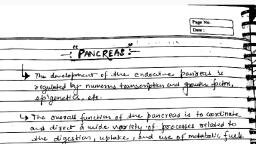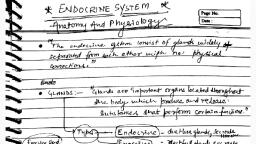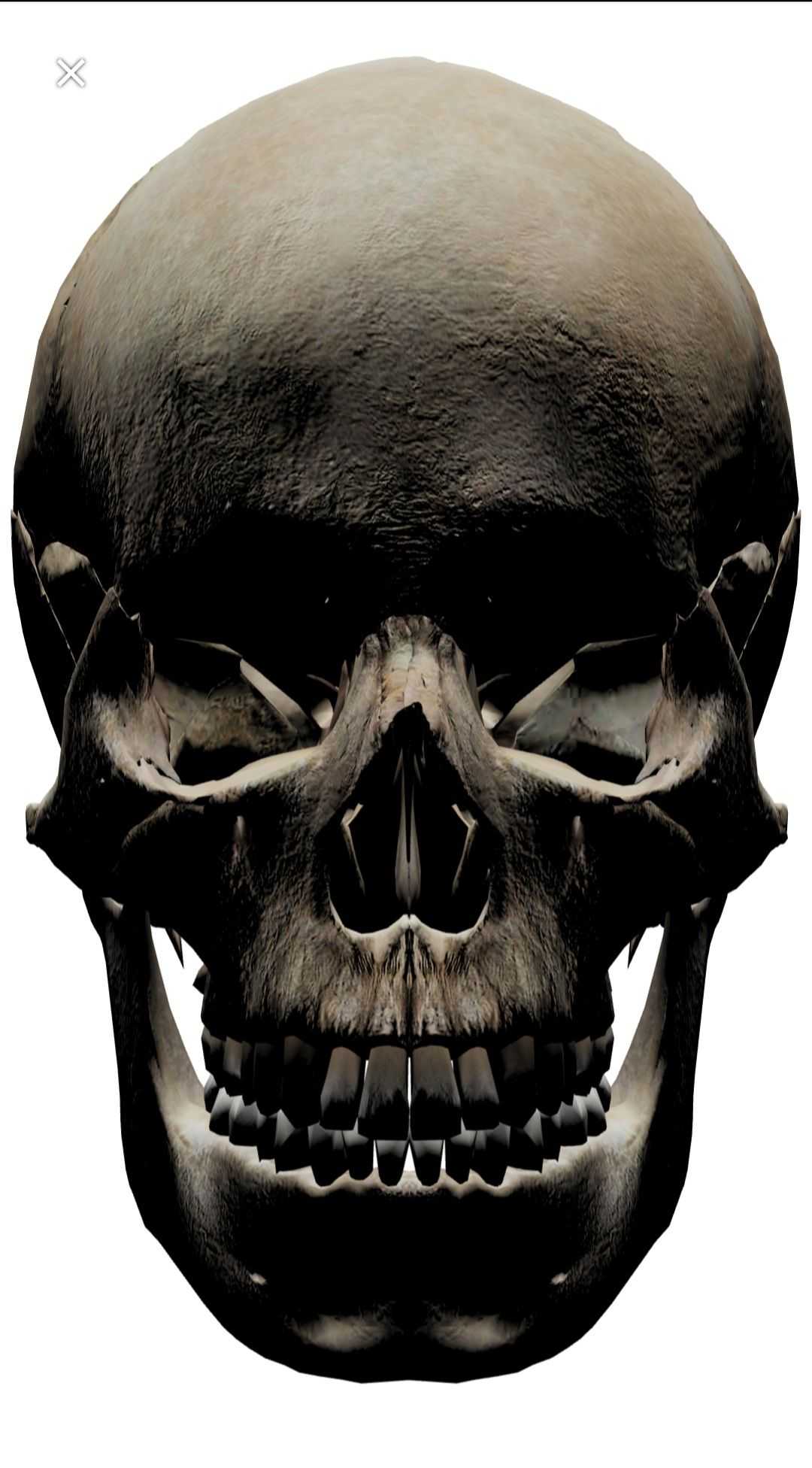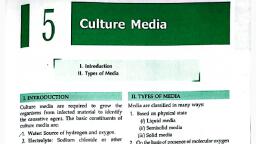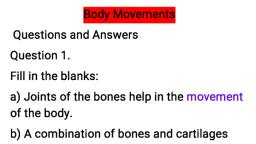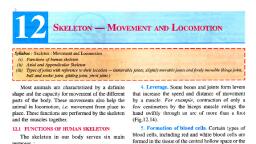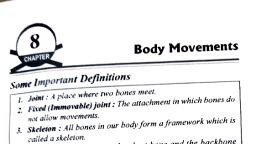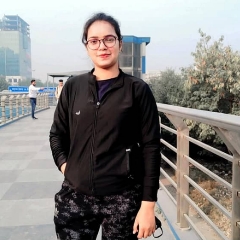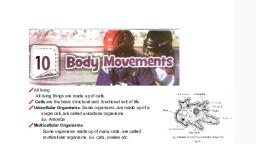Page 1 :
THE SKELETAL SYSTEM, , COMPILED BY HOWIE BAUM
Page 2 :
INTRODUCTION, With its highly engineered joints, the, living skeleton is intimately, connected with the muscular, system., It provides a framework of stiff levers, and stable plates that permits a, multitude of movements., The skeleton also integrates, functionally with the, cardiovascular system – as every, second, millions of fresh blood, cells pour out of the bone, marrow., A healthy diet that provides enough, minerals, especially calcium, along, with regular moderate exercise, can, reduce the risks of many bone and
Page 3 :
INTERESTING FACTS ABOUT THE SKELETON, The skeleton makes up almost one-fifth of a healthy body’s weight., This flexible inner framework supports all other parts and tissues, which would collapse, without skeletal reinforcement., It also protects certain organs, such as the delicate brain inside the skull., Bones are reservoirs of important minerals, especially calcium, and also make new cells, for the blood., About one person in 20 has an extra rib., Bone is an active tissue, and even though it is about 22 per cent water, it has an, extremely strong yet lightweight and flexible structure., A similar frame made of high-technology composite materials could not match the, skeleton’s weight, strength, and durability. It’s as strong as steel but light as aluminum., It can repair itself if damaged and can remodel its bones to thicken and strengthen them, in areas of extra stress, when persons do extreme sports.
Page 4 :
The skeleton is, the framework, that provides, structure to the, rest of the, body and, facilitates, movement.
Page 5 :
When you look at the human, skeleton the 206 bones and 32, teeth stand out., But look closer and you’ll see, even more structures., The human skeleton also, includes ligaments and, cartilage., Ligaments are bands of dense, and fibrous connective tissue that, are key to the function of joints., Cartilage is more flexible than, bone but stiffer than muscle., Cartilage helps give structure to, the larynx and nose. It is also, found between the vertebrae and, at the ends of bones like the, femur.
Page 6 :
LIGAMENTS, Ligaments are strong bands or, straps of fibrous tissue that provide, support to bones and link bone, ends together in and around joints., They are made of collagen – a, tough, elastic protein., A large number of ligaments bind, together the complex wrist and, ankle joints, The foot ligaments store energy, as they stretch when the foot is, planted and then impart it, again as they recoil and shorten, to put a “spring in the step”., This saves an enormous, amount of energy when, walking.
Page 7 :
These bones provide structure and, protection and facilitate motion., Bones are arranged to form, structures., The skull protects the brain and, gives shape to the face., The thoracic cage surrounds the, heart and lungs., The vertebral column, commonly, called the spine, is formed by over, 30 small bones., Then there are the limbs (upper and, lower) and the girdles that attach, the four limbs to the vertebral, column.
Page 8 :
THE SKELETON PROTECTS, VITAL ORGANS, The brain is surrounded by, bones that form part of the, skull., The heart and lungs are, located within the thoracic, cavity, and the vertebral, column provides structure and, protection for the spinal cord.
Page 9 :
INTERACTIONS BETWEEN THE, SKELETON, MUSCLES, AND NERVES, MOVE THE BODY, How does the skeleton move?, Muscles throughout the human body are, attached to bones., Nerves around a muscle can signal the, muscle to move., When the nervous system sends, commands to skeletal muscles, the, muscles contract., That contraction produces movement at, the joints between bones., https://www.youtube.com/watch?v=59r9TG5IfU8&feature=emb_logo
Page 10 :
BONES ARE GROUPED INTO THE AXIAL, SKELETON AND THE APPENDICULAR, SKELETON, Bones of the appendicular skeleton, facilitate movement - girdles and limbs, Bones of the axial skeleton protect, internal organs – skull, vertebral, column and thoracic cage, Of the 206 bones, 80 are in the axial, skeleton, with 64 in the upper, appendicular and 62 in the lower, appendicular skeleton.
Page 11 :
BONES CAN BE CLASSIFIED, INTO FIVE TYPES, Bones of the human skeletal, system are categorized by their, shape and function into five types., The femur is an example of a long, bone., The frontal bone is a flat bone., The patella, also called the knee, cap, is a sesamoid bone., Carpals (in the hand) and tarsals, (in the feet) are examples of short, bones., Vertebrae are classified as, Irregular shaped bones.
Page 12 :
LONG BONES HAVE THREE, MAIN PARTS, TO THEM, The outside of a long bone, consists of a layer of compact, bone surrounding spongy bone., Red bone marrow contains, haemopoietic tissue, the chief, function of which is to produce, all three main kinds of blood, cell: red; white; and, platelets., At birth, red marrow is, present in all bones, but, with increasing age, in the, long bones it gradually, becomes yellow marrow, and loses its blood-making, capacity.
Page 13 :
SOME BONES PRODUCE, RED BLOOD CELLS, Red bone marrow is soft tissue located in, networks of spongy bone tissue inside some, bones. (shown in blue in the image), In adults the red marrow in bones produce, blood cells of the:, Cranium (skull), Vertebrae, Scapulae (shoulder bones), Sternum (bone in the center of the chest), Ribs, Pelvis, The epiphyseal ends of the large long, bones
Page 14 :
SOME JOINTS DON'T MOVE OR MOVE, VERY LITTLE, One way to classify joints is by range of, motion., Immovable joints include:, Sutures of the skull, Articulations between teeth and the, mandible, The joint located between the first pair, of ribs and the sternum., Some joints have slight movement; an, example is the distal joint between the, tibia and fibula. Joints that allow a lot of, motion (think of the shoulder, wrist, hip,, and ankle) are located in the upper and, lower limbs.
Page 15 :
INFANTS HAVE MORE BONES, THAN ADULTS, An infant skeleton has almost 100, more bones than the skeleton of an, adult !, At first, it is all flexible but strong, cartilage., Bone formation begins at about three, months gestation and continues after birth, into adulthood., An example of several bones that fuse, over time into one bone is the sacrum., At birth, the sacrum is five vertebrae, with discs in between them., The sacrum is fully fused into one bone, usually by the fourth decade of life.
Page 16 :
FLAT BONES PROTECT, INTERNAL ORGANS, There are flat bones in, the skull (occipital, parietal, frontal,, nasal, lacrimal, and vomer),, the thoracic cage (sternum and ribs), the pelvis (ilium, ischium, and pubis)., The function of flat bones is to protect, internal organs such as the brain, heart,, and pelvic organs., Flat bones can provide protection, like a, shield and can also provide large areas of, attachment for muscles.
Page 17 :
LONG BONES SUPPORT WEIGHT, AND FACILITATE MOVEMENT, The long bones, longer than they, are wide, include:, The femur (the longest bone in the, body), Relatively small bones in the fingers., Long bones are mostly located in, the appendicular skeleton and, include, The lower limbs, Bones in the upper limbs
Page 18 :
SHORT BONES ARE CUBESHAPED, Short bones are about as long, as they are wide., Located in the wrist and ankle, joints, short bones provide, stability and some movement., Examples of short bones, are:, The carpals in the wrist, The tarsals in the ankles
Page 19 :
IRREGULAR BONES HAVE, COMPLEX SHAPES, Irregular bones vary in shape and, structure and therefore do not fit into, any other category (flat, short, long, or, sesamoid)., They often have a fairly complex shape,, which helps protect internal organs., For example, the vertebrae, irregular, bones of the vertebral column, protect, the spinal cord., The irregular bones of the pelvis protect, organs in the pelvic cavity.
Page 20 :
SESAMOID BONES, REINFORCE TENDONS, Sesamoid bones are bones, embedded in tendons., These small, round bones are, commonly found in the tendons, of the hands, knees, and feet., Sesamoid bones function to, protect tendons from stress and, wear., The patella, commonly, referred to as the kneecap, is, an example of a sesamoid, bone.
Page 21 :
SKULL BONES PROTECT THE, BRAIN AND FORM AN, ENTRANCE, TO THE BODY, The skull consists of the cranial, bones and the facial skeleton., The cranial bones compose the top, and back of the skull and enclose, the brain., The facial skeleton, as its name, suggests, makes up the face of the, skull.
Page 22 :
FACIAL SKELETON, The 14 bones of the facial, skeleton form the entrances, to the respiratory and, digestive tracts., It is made up of:, The facial skeleton is, formed by the mandible,, maxillae (r,l), and the, zygomatics (r,l),, The bones that give, shape to the nasal cavity
Page 23 :
CRANIAL BONES, The eight cranial bones support, and protect the brain:, Occipital bone, Parietal bone (r,l), Temporal bone (r,l), Frontal bone, Ethmoid
Page 24 :
SKULL SUTURES - In fetuses and newborn infants, cranial, bones are connected by flexible fibrous sutures, including, large regions of fibrous membranes called fontanelles., These regions allow the skull to enlarge to accommodate the, growing brain., The sphenoidal, mastoid, and posterior fontanelles close after, two months, while the anterior fontanelle may exist for up to, two years., As fontanelles close, sutures develop. Skull sutures are immobile, joints where cranial bones are connected with dense fibrous tissue., The four major cranial sutures are:, lambdoid suture (between the occipital and parietal bones), coronal suture (between the frontal and parietal bones), sagittal suture (between the two parietal bones), squamous sutures (between the temporal and parietal bones), , https://www.youtube.com/watch?v=tM3O, QR_7u4Q
Page 25 :
The Hyoid Bone, Laryngeal, Skeleton, and Bones of the, Inner Ear Are Commonly, Categorized with Skull Bones, BONES OF THE INNER EAR, Inside the petrous part of the, temporal bone are the three, smallest bones of the body:, Malleus, Incus, Stapes (this is the smallest, bone in the body !!), These three bones articulate with, each other and transfer vibrations, from the tympanic membrane to, the inner ear.
Page 26 :
The laryngeal skeleton, also, known as the larynx or voice, box, is composed of nine, cartilages., It is located between the, trachea and the root of the, tongue., The hyoid bone provides an, anchor point., The movements of the, laryngeal skeleton both open, and close the glottis and, regulate the degree of tension, of the vocal folds, which–when, air is forced through them–, produce vocal sounds.
Page 27 :
THE BONES OF THE VERTEBRAL, COLUMN: THE VERTEBRAE,, SACRUM, AND COCCYX, The vertebral column is a flexible column, formed by a series of 24 vertebrae, plus the, sacrum and coccyx., Commonly referred to as the spine, the, vertebral column extends from the base of, the skull to the pelvis., The spinal cord passes from the foramen, magnum of the skull through the vertebral, canal within the vertebral column., The vertebral column is grouped into five, regions:, cervical spine (C01-C07),, thoracic spine (T01- T-12, lumbar spine (L01-L05), sacral spine, coccygeal spine
Page 28 :
The spine is also known as the spinal, or vertebral column, or simply “the, backbone”. This strong yet flexible, central support holds the head and, torso upright yet allows the neck and, back to bend and twist., Spine function, The spine consists of 33 ring-like, bones called vertebrae., With the S shape, it acts like a, spring and can flex when we are, young and jump off of something., If it was straight up and down, it, could break easily., The bottom nine vertebrae are fused, into two larger bones termed the, sacrum and the coccyx, leaving 26, movable components within the spine.
Page 29 :
Spinal joints, Spinal joints do not have, a wide range of, movement, but they still, allow the spine great, flexibility, letting it arch, backwards, twist, and, curve forward., Two facet joints help to, prevent slippage and, torsion.
Page 30 :
THE BONES OF THE, THORACIC CAGE PROTECT, INTERNAL ORGANS, The thoracic cage, formed by, the ribs and sternum, protects, internal organs and gives, attachment to muscles involved, in respiration and upper limb, movement., The sternum consists of the, manubrium, body of the, sternum, and xiphoid process., Ribs 1-7 are called true ribs, because they articulate directly, to the sternum, Ribs 8-12 are known as false, ribs.
Page 31 :
BONES COME TOGETHER: TYPES OF JOINTS IN, THE HUMAN BODY, Joints hold the skeleton together and support movement., There are two ways to categorize joints. The first is by, joint function, also referred to as range of motion., The second way to categorize joints is by the material, that holds the bones of the joints together; that is an, organization of joints by structure., Joints in the human skeleton can be grouped by function, (range of motion) and by structure (material)., Joint, , Range of Motion and Material, , Skull Sutures, , Immovable fibrous joints, , Knee, , Full movement synovial capsule, hinge joint, , Vertebrae, , Some movement - cartilaginous, joint
Page 32 :
JOINTS CAN ALSO BE, GROUPED BY THEIR, FUNCTION INTO 3 RANGES OF, MOTION, Immovable joints, Joints that allow a slight, movement, Joints allowing full movement, include many bone articulations, in the upper and lower limbs,, such as the elbow, shoulder,, and ankle.
Page 35 :
JOINTS CAN BE GROUPED BY THEIR STRUCTURE, INTO FIBROUS, CARTILAGINOUS,, AND SYNOVIAL JOINTS, Fibrous Joints – Most of these have thick, connective tissue between them which is why, most are immovable., There are three types of fibrous joints:, (1) Sutures are nonmoving joints that connect, bones of the skull., (2) The fibrous articulations between the, teeth and the mandible or maxilla, (3) A syndesmosis is a joint in which a, ligament connects two bones, allowing for a little, movement
Page 36 :
CARTILIGINOUS JOINTS., Joints that unite bones with, cartilage are called cartilaginous, joints., There are two types of, cartilaginous joints:, (1) A synchrondosis is an, immovable cartilaginous joint., One example is the joint, between the first pair of ribs, and the sternum., (2) A symphysis consists of a, compressible fibro-cartilaginous, pad that connects two bones,, such as the hip bones and the, vertebrae.
Page 37 :
SYNOVIAL JOINTS, Synovial joints are characterized by the presence of a, capsule between the two joined bones., Bone surfaces at synovial joints are protected by a coating of, articular cartilage. Synovial joints are often supported and, reinforced by surrounding ligaments, which limit movement, to prevent injury., There are six types of synovial joints:, (1) Gliding joints, (2) Hinge joints, (3) A pivot joint which provides rotation., (4) A condyloid joint allows for circular motion, flexion, and, extension, (5) A saddle joint, (6) The ball-and-socket joint such as in the hip and shoulder
Page 38 :
Synovial joints are enclosed, by a protective outer, covering – the joint, capsule., The capsule’s inner lining,, called the synovial, membrane, produces, slippery, oil-like synovial, fluid that keeps the joint, well lubricated so that the, joint surfaces in contact, slide with minimal friction, and wear., There are around 230, synovial joints in the body.
Page 40 :
THE 6 BONE JOINTS
Page 42 :
THE BONES OF THE, SHOULDER GIRDLE, The pectoral or shoulder, girdle consists of the, scapulae and clavicles., The shoulder girdle connects, the bones of the upper limbs, to the axial skeleton., These bones also provide, attachment for muscles that, move the shoulders and, upper limbs.
Page 43 :
BONES OF THE UPPER, LIMBS, The upper limbs include the, bones of the arm (humerus),, forearm (radius and ulna),, wrist, and hand., The only bone of the arm is the, humerus, which articulates with, the forearm bones–the radius, and ulna–at the elbow joint., The ulna is the larger of the two, forearm bones.
Page 44 :
WRIST BONES., The wrist, or carpus, consists of, eight carpal bones., One mnemonic to remember, the carpal bones is the, sentence: Some Lovers Try, Positions That They Can’t, Handle., The eight carpal bones of the, wrist are the Scaphoid, Lunate,, Triquetral, Pisiform, Trapezoid,, Trapezium, Capitate, and, Hamate.
Page 45 :
HAND BONES., The hand includes:, 8 bones in the wrist, 5 bones that form the palm, 14 bones that form the fingers and, thumb., The wrist bones are called carpals., The bones that form the palm of the, hand are called metacarpals., The phalanges are the bones of the, fingers.
Page 46 :
THE BONES OF THE PELVIS, The pelvic girdle is a ring of, bones attached to the vertebral, column that connects the bones of, the lower limbs to the axial, skeleton., The pelvic girdle consists of the, right and left hip bones., Each hip bone is a large, flattened,, and irregularly shaped fusion of, three bones:, Ilium, Ischium, Pubis
Page 47 :
FEMALE AND MALE PELVIS., The female and male pelvises, differ in several ways due to, childbearing adaptations in the, female., The female pelvic brim is, larger and wider than the, male’s., The angle of the pubic arch is, greater in the female pelvis, (over 90 degrees) than in the, male pelvis (less than 90, degrees)., The male pelvis is deeper and, has a narrower pelvic outlet, than the female’s.
Page 48 :
THE BONES OF THE LOWER LIMBS, The lower limbs include the bones of, the thigh, leg, and foot., The femur is the only bone of the, thigh. It is the biggest bone in, the body !!, It articulates with the two bones of the, leg–the larger tibia (commonly known, as the shin) and smaller fibula., The thigh and leg bones articulate at, the knee joint that is protected and, enhanced by the patella bone that, supports the quadriceps tendon., .
Page 49 :
FOOT BONES., The bones of the foot consist of:, tarsal bones of the ankle, phalanges that form the toes,, metatarsals that give the foot its, arch., As in the hand, the foot has:, five metatarsals, five proximal phalanges, five distal phalanges, only four middle phalanges (as the, foot’s “big toe” has only two, phalanges).
Page 50 :
WALKING PRESSURE, With each step, the, main weight of the, body moves from the, rear to the front of, the foot., The heel region bears, initial pressure as the, foot is put down., The force passes along, the arch, which flattens, slightly, then recoils to, transfer the energy and, pressure to the ball of, the foot, and finally to, the big toe for the, push-off.
Page 51 :
ANKLE BONES., The ankle, or tarsus,, consists of 7 tarsal, bones:, Calcaneus, Talus, Cuboid, Navicular, 3 Cuneiforms
Page 52 :
GAMES WITH SHEEP OR GOAT ANKLE BONES, The astragalus or talus bone, the ankle bone, usually taken from goats or sheep., They have been used in games of chance and skill since at least 3500 BCE., When tossed in the air, they will land with one of four sides face up, sometimes referred to as Camel,, Goat, Horse and Sheep (see photo)., Because of the irregularities of each bone, the probabilities of landing on any side are not equal as they, are for dice. Games evolved with these differences in mind., Dice were originally made from these bones, colloquially known as "knucklebones“ which, lead to the nickname "bones" for dice., The photo below is of one astragulus bone taken from a sheep, with it’s 4 sides and their names shown.
Page 53 :
FOOT ARCHES, The arches of the foot are, formed by the interlocking, bones and ligaments of the, foot., They serve as shock-aborbing, structures that support body, weight and distribute stress, evenly during walking., The longitudinal arch of the foot, runs from the calcaneus to the, heads of the metatarsals and, has medial and lateral parts., The transverse arch of the foot, runs across the cuneiforms and, the base of the metatarsal, bones.
Page 54 :
THANK YOU !!



